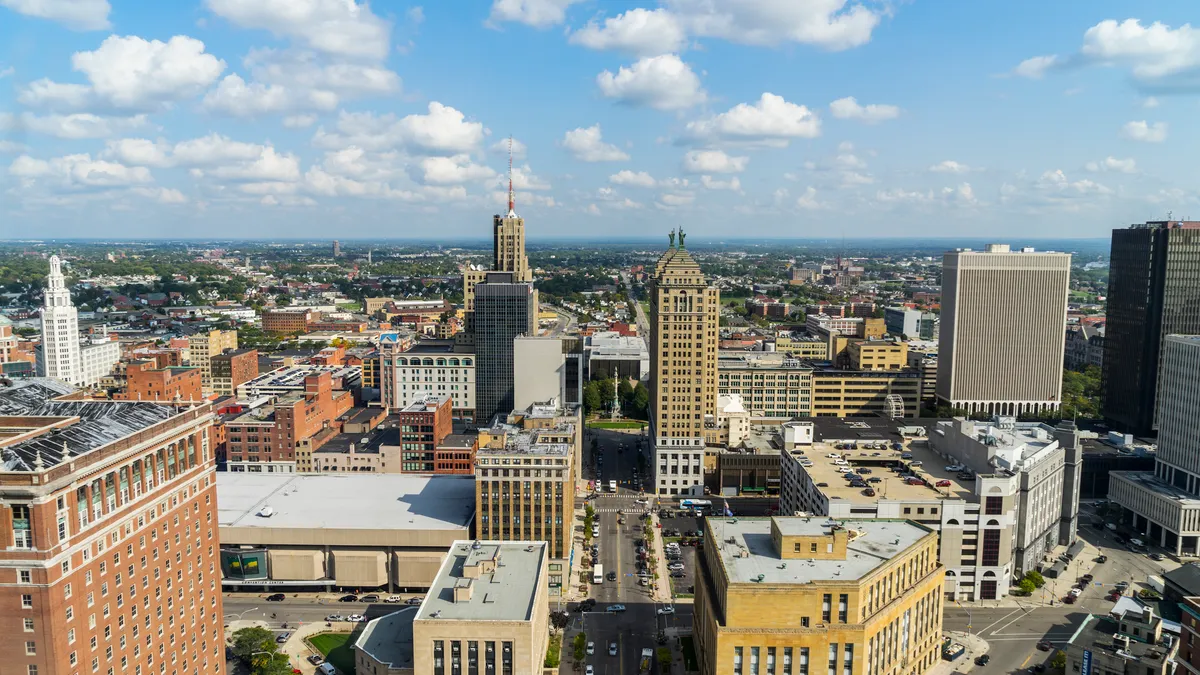The time is ripe for smaller, older industrial cities in the U.S. to undergo “green regeneration” — becoming more equitable, economically revitalized and environmentally friendly — according to a report released this month by the Massachusetts-based think tank Lincoln Institute of Land Policy.
Many of these “legacy cities,” concentrated in the American Rust Belt, were once thriving centers of industry, but have faced population loss and disinvestment in the decades since World War II. Today, the report says, these cities face “vast swaths of stranded properties, crumbling infrastructure, widespread entrenched poverty, and pervasive environmental health issues in predominantly nonwhite neighborhoods.”
“Many of these places have been forgotten, and we remember them again in times of crisis,” said Jessie Grogan, the institute’s associate director of reduced poverty and spatial inequality. For example, she said, fallout from the late-2000s mortgage crisis hit these cities particularly hard. “I will betray my politics by calling the election of Trump a crisis,” Grogan added. “It showed the the political challenges of creating swaths of the country that feel left behind and disconnected.”
Despite these challenges, the report says smaller legacy cities are uniquely positioned to be reborn as climate-resilient hubs that drive the nation’s low-carbon future by supporting nearby green agriculture and manufacturing.
Due to their declining populations, many of these cities have an abundance of vacant or underutilized lots able to be leveraged into ecosystems that improve communities’ climate resilience by, for example, cooling neighborhoods or reducing flooding, Grogan said. This concept is known as “blue-green infrastructure.”
The industrial histories of these cities will also serve them well amid burgeoning green manufacturing and the federal push for green economic redevelopment, Grogan said. That’s because many of these cities already have the existing physical infrastructure and skilled workforce related to manufacturing, she said.
The green energy transition also poses an opportunity for the buildout of local “cottage industries,” Grogan added. For example, she said, the budding offshore wind industry in New Bedford, Massachusetts, has driven the development of smaller, local manufacturers who make the turbine components.
These cities could also help close the nation’s stark urban-rural divide, as they serve as regional economic centers and county seats.
“Most people in the U.S. live in these smaller regions where they have a city that anchors the region, but it's not necessarily a huge city,” Grogan said. “This, to some extent, is closer to the reality of many U.S. residents.”
The report says that smaller legacy cities’ “sense of scale differs from that of big-money, big-innovation global cities and thus offers a more modest antidote to our current lopsided winner-take-all economic terrain.”
To help leaders in smaller legacy cities prepare their communities for climate change, the report outlines seven recommendations:
- Utilize land-use plans and codes to advance green initiatives. “Working closely with community participants, local officials should screen comprehensive plans and zoning ordinances for climate resilience and equity features, and inventory existing buildings, housing, and neighborhoods to better inform comprehensive and sustainability planning,” the report says.
- Embed environmental justice in greening interventions. Cities should map environmental justice “trouble spots,” mitigate further harm and prevent dangerously polluting activities from being sited near dense neighborhoods.
- Support clean energy generation and energy equity. Local governments should consider urban brownfields, dead malls and big-box stores as sites for clean energy generation.
- Establish a stand-alone sustainability office. To take full advantage of federal and other funding opportunities while they last, cities must have skilled staff.
- Support local small businesses. “Local governments should do everything they can to ensure new federal funding for equitable infrastructure, manufacturing, and clean energy goes to small businesses that support green job growth and career ladders, keep wealth circulating locally, and increase the tax base,” the report says.
- Establish regional alliances. Smaller legacy cities often struggle with a lack of technical and financial capacity, making regional alliances crucial.
- Build a network of cross-sector greening support. Cities could partner with colleges, nonprofit groups, climate equity advocates or sustainability alliances.












